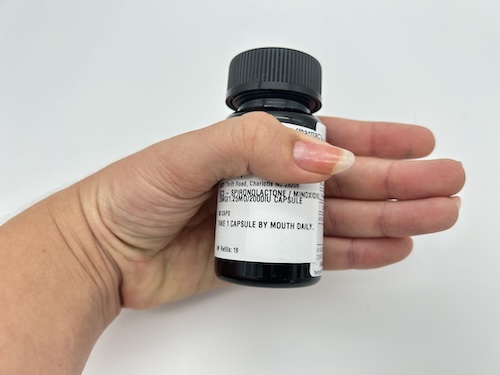Spironolactone for Hair Loss: Does It Work for Women?
Key Takeaways
- Spironolactone is a blood pressure medication that’s prescribed off-label for the treatment of female-pattern hair loss (FPHL) and is available in oral and topical formulas.
- The cost of spironolactone ranges from $15–$79 per month, depending on its formulation and where it’s purchased.
- Spironolactone, a diuretic that’s an FDA-approved medication for high blood pressure, heart failure, and other conditions, is used for hair loss because it blocks the hormone receptors that can cause hair loss in women.
- Because it blocks androgens (male sex hormones), spironolactone is only prescribed for hair loss to women.
- Dermatologists say spironolactone can be safe to use as part of a comprehensive treatment plan for women experiencing hair thinning and hair loss.
Hair loss can be the result of stress, genetic factors, vitamin and mineral deficiencies, or it could be a symptom of certain health conditions. Androgenic alopeciaⓘ A genetic disorder characterized by the gradual loss of hair in the crown and frontal areas of the scalp , also known as pattern hair loss, is the most common type of hair loss for both men and women. Unlike male-pattern hair loss, female-pattern hair loss (FPHL) initially shows up as a widening hair part and gradual hair thinning. Hair loss can damage self-confidence, and studies show the psychological impact of hair loss can be more severe for women than for men.
People who are experiencing FPHL can see a dermatologist to find out if they’re eligible for prescription oral or topical medications to prevent further hair thinning and promote hair regrowth. In this article, we’ll provide an overview of spironolactone, a prescription medication that’s used for the treatment of FPHL, and explore its effectiveness and safety. Read on to learn key details about the medication, including its side effects and who it could be good for. Before starting any new medication, consult with your doctor to make sure it is appropriate for you considering the cause of your hair loss, health conditions you have, and other medications you may be taking. You can also read our review of the best hair loss treatments for women to learn about other options.
Hers for spironolactone
Hers is a telemedicine platform that carries non-prescription and prescription oral and topical medications for women experiencing hair thinning and hair loss. It could be an ideal way for women to receive hair loss treatments without visiting an in-person doctor’s office.
What is spironolactone?
Spironolactone is a generic medication available in oral form for on-label useⓘ Used for the specific purpose the medication was developed , and in oral and topical forms for off-label useⓘ Used for a purpose other than what the medication is intended to treat . As an on-label medication, spironolactone is used to treat high blood pressure, low potassium, heart failure, fluid retention, and excess aldosterone (a naturally occurring hormone). As an off-label medication, spironolactone is used for female pattern hair loss and other dermatological conditions, like acne. Observational studies have reported positive results for spironolactone as an effective treatment for FPHL.
Brand-name versions of spironolactone include Aldactone and Carospir.
How spironolactone works for hair loss
AGA, or pattern hair loss, is related to a higher production of male sex hormones known as androgens, which includes the hormone testosterone. Females with AGA may have highly sensitive androgen receptors due to genetics, health conditions such as polycystic ovary syndrome (PCOS), or hormonal imbalances related to menopause.
According to Ross Kopelman, MD, a hair transplant surgeon at Kopelman Hair Restoration in New York City, spironolactone slows female pattern hair loss by reducing the production of dihydrotestosteroneⓘ A hormone that binds to hair follicles, causing them to shrink and produce thinner, finer hair strands (DHT), a hormone linked to hair loss.
When combined with oral minoxidil, another popular hair loss medication, women may experience stimulated hair growth and increased hair density. Dr. Kopelman says he often prescribes spironolactone as part of a dual treatment plan for his patients. “While it doesn’t stimulate new hair growth directly, it effectively slows down or halts further hair loss, allowing other treatments like topical minoxidil or hair transplant surgery to show more pronounced results,” he said.
Our experience with spironolactone for hair loss

Key features
- Price: Varies depending on where and how it is purchased, but our research shows an average of $15–$79 per month
- Brand names: Aldactone and Carospir
- Forms available: Oral and topical
- FDA-approved: Yes for other uses, but not hair loss
- Prescription required: Yes
Pros and cons
Pros
- Slows hair thinning for females with androgenic alopecia
- Found to be effective in multiple studies
- Safe to use with minoxidil
Cons
- May interact negatively with several prescription and over-the-counter medications and supplements
- Not effective for non-hormonal hair loss in women
- Not suitable for women who are pregnant or breastfeeding
Our expert take
Spironolactone is a medication originally created to treat high blood pressure and fluid retention, but it has also been prescribed off-label for decades to treat women who are experiencing hair loss caused by AGA. According to the American Academy of Dermatology, AGA in women typically starts around mid-life, appearing as a widening of the hair part and overall thinning of hair.
AGA is caused by sensitivity to an overproduction of androgens, male sex hormones that are found in small amounts in women and play a part in the regulation of hair growth. About half of women experience some amount of hair loss related to hormone imbalances during menopause.
Blood tests can determine if someone has an over-production of androgens, which can help diagnose if AGA is the cause of hair loss. This is important because spironolactone is not an effective treatment for hair loss caused by non-hormonal conditions like stress and vitamin and mineral deficiencies. Certain telehealth platforms, like Nurx and Ro, may include blood tests as part of your evaluation. Providers on these platforms can order a lab test for you to help determine the cause of your hair loss. An at-home test kit will be mailed to you with instructions on how to complete it. You will then mail the completed test back to a lab for analysis.
One of the benefits of spironolactone is that it can be safely combined with other medications used to treat hair loss in women, such as minoxidil. When shopping for hair loss treatments on telehealth subscription platforms, you may find that spironolactone is commonly combined with minoxidil in either its oral or topical form.
The usual spironolactone dosage prescribed by dermatologists is between 100 and 200 milligrams (mg) daily. Some spironolactone doses for hair loss can be as low as 25 mg to lessen the risk of side effects. The exact dosage your doctor prescribes will depend on the stage of your hair loss and whether spironolactone is being combined with other treatments.
Spironolactone can take time for it to become effective. When we interviewed users of spironolactone for hair loss, they said they did not see changes in hair density early on. Most women taking spironolactone can expect to see results between six months to one year when taken as prescribed. If you’re seeing little to no change, your doctor may alter your dosage or change your overall treatment.

“I have been taking spironolactone for about a year. I have been taking it for acne but have noticed growth in my hairline. I had some bad breakage and missing hair around my hairline. It has taken some time but I do now notice my hairline being fuller when I put my hair up.”
– From our tester
Our recommendation
Who may find spironolactone a useful treatment for hair loss
- Women who have hair loss related to PCOS or menopause
- Women with female pattern hair loss and acne
- Women who want to support hair regrowth in combination with minoxidil
Who may want to avoid spironolactone for hair loss
- Women with kidney disease or high potassium levels
- Women whose hair loss is related to stress or nutritional deficiencies
- Women who are pregnant or looking to become pregnant
What are the side effects of spironolactone for hair loss?
One thing to keep in mind with all prescription hair loss medications is their potential side effects. According to recent research published in the journal Cureus, common mild side effects of spironolactone include:
- Drowsiness
- Headache
- Lightheadedness
- Fatigue
- Muscle spasms or cramps
- Nausea or vomiting
- Irregular menstruation
- Tender breasts
- Reduced sex drive
Mild side effects may go away on their own with regular use after several weeks or months. More serious side effects of spironolactone are related to the medication’s ability to affect blood pressure and potassium levels.
As a diuretic, spironolactone helps to remove liquids from your body while retaining potassium in your blood. If you have normal blood potassium levels, your doctor may recommend avoiding high potassium foods and schedule you for occasional blood tests to monitor your potassium levels throughout your treatment, as well as regularly checking your blood pressure and electrolyte levels.
“For women over 65, regular checkups are crucial to monitor potassium levels and kidney function, as spironolactone can sometimes interfere with these,” said Dr. Kopelman.
If you notice any of the following severe side effects or symptoms related to hyperkalemia (high potassium levels), contact your doctor as soon as possible:
- Allergic reactions such as hives, fever, or difficulty breathing
- Stomach pain
- Diarrhea
- Vomiting
- Chest pain
- Heart palpitations or changes in heartbeat
- Severe dehydration
- Muscle fatigue or paralysis
- Kidney issues
Is it safe to use spironolactone for hair loss?
The dermatologists we consulted said that spironolactone is generally safe, but that you need to use the prescription under the supervision of a health care provider.
When speaking to your dermatologist or primary care doctor about spironolactone, be sure to share other medications and supplements you’re taking, as well as any preexisting health conditions. Spironolactone can negatively interact with several prescription and over-the-counter drugs, and may cause harmful side effects.
Examples of drugs that may interact with spironolactone include but are not limited to:
- Eplerenone
- Nonsteroidal anti-inflammatory drugs (NSAIDs)
- Angiotensin-converting enzyme (ACE) inhibitors
- Ibuprofen
- Naproxen
- Lithium
- Digoxin
The drug label for Aldactone (spironolactone) states that women who are pregnant or planning to become pregnant should not use spironolactone due to the potential risks to fetal development. Spironolactone may also pose risks while breastfeeding.
As kidney function decreases with age, women over age 65 are at a higher risk for developing hyperkalemia, or high potassium, when prescribed spironolactone for hair loss. Health care providers may make special considerations for postmenopausal women 65 and older when prescribing spironolactone.
“Before prescribing spironolactone to older women, I typically recommend close monitoring and adjustments in dosage as needed to ensure it’s safe and effective,” said Dr. Kopelman.
Bottom line
Although it is not FDA-approved as a hair loss drug, studies have shown spironolactone can be safe and effective for reducing hair thinning in women with androgenic alopecia from hormone imbalances. When combined with minoxidil, the effects may be even more noticeable.
Spironolactone is not an effective treatment for hair loss caused by non-hormonal conditions like stress and vitamin or mineral deficiencies. There are also side effects and drug interactions women should keep in mind. Always speak to a doctor, like your primary care provider, before starting new medications so you can have your health history assessed along with any other medications and supplements you may be taking to ensure the medication will be safe and effective for you to use.
Frequently asked questions
Spironolactone is commonly prescribed off-label to treat female pattern hair loss (FPHL) caused by hormone imbalances. Studies have shown the medication to be an effective way to prevent hair thinning when taken orally or applied topically. Whether spironolactone could be an effective treatment for you depends on the cause of your hair loss and your overall health.
Women using oral or topical spironolactone for hair loss can expect to see results between six months and one year. If you don’t notice a difference in hair thickness or hair density after this amount of time, your doctor may alter your dosage or hair loss treatment plan.
Minoxidil is a commonly prescribed hair loss medication for men and women with androgenic alopecia. Although spironolactone and minoxidil can both be effective treatments, they are generally best suited for different hair growth goals and different health concerns. Minoxidil is better for men experiencing male-pattern baldness or for people who want to stimulate hair follicles for increased growth.
Have questions about this review? Email us at reviewsteam@ncoa.org.
Sources
- Almohanna HM, et al. The Role of Vitamins and Minerals in Hair Loss: A Review. Dermatology and Therapy. Dec. 13, 2018. Found on the internet at https://link.springer.com/article/10.1007/s13555-018-0278-6
- American Academy of Dermatology Association. Hair Loss: Who Gets and Causes. Found on the internet at https://www.aad.org/public/diseases/hair-loss/causes/18-causes
- Dhami, L. Psychology of Hair Loss Patients and Importance of Counseling. Indian Journal of Plastic Surgery. October 2021. Found on the internet at https://www.thieme-connect.de/products/ejournals/html/10.1055/s-0041-1741037
- Davis DS and Callender VD. Review of Quality of Life Studies in Women With Alopecia. International Journal of Women’s Dermatology. March 2018. Found on the internet at https://www.sciencedirect.com/science/article/pii/S2352647517300989?via%3Dihub
- National Library of Medicine. Spironolactone. Found on the internet at https://medlineplus.gov/druginfo/meds/a682627.html
- de Souza B, et al. The Off-Label Use of Spironolactone in Female Pattern Hair Loss. Journal of the American Academy of Dermatology. December 2020. Found on the internet at https://www.jaad.org/article/S0190-9622(20)31678-9/abstract
- Famenini S. et al. Demographics of Women With Female Pattern Hair Loss and the Effectiveness of Spironolactone Therapy. Journal of the American Academy of Dermatology. October 2015. Found on the internet at https://www.jaad.org/article/S0190-9622(15)01878-2/fulltext
- Sinclair RD. Female-Pattern Hair Loss: A Pilot Study Investigating Combination Therapy With Low-dose Oral Minoxidil and Spironolactone. International Journal of Dermatology. Dec. 12, 2017. Found on the internet at https://pubmed.ncbi.nlm.nih.gov/29231239/
- American Academy of Dermatology Association. Thinning Hair and Hair Loss: Could It Be Female-Pattern Hair Loss? Dec. 13, 2022. Found on the internet at https://www.aad.org/public/diseases/hair-loss/types/female-pattern
- Chaikittisilpa S, et al. Prevalence of Female Pattern Hair Loss in Postmenopausal Women: A Cross-sectional Study. The Journal of The Menopause Society. April 2022. Found on the internet at https://journals.lww.com/menopausejournal/abstract/2022/04000/prevalence_of_female_pattern_hair_loss_in.7.aspx
- Aleissa M. The Efficacy and Safety of Oral Spironolactone in the Treatment of Female Pattern Hair Loss: A Systematic Review and Meta-Analysis. Cureus. Aug. 16, 2023. Found on the internet at https://www.ncbi.nlm.nih.gov/pmc/articles/PMC10502763/
- National Kidney Foundation. Hyperkalemia (High Potassium). Found on the internet at https://www.kidney.org/kidney-topics/hyperkalemia-high-potassium
- Pfizer Labs. Aldactone Highlights of Prescribing Information. September 2023. Found on the internet at https://labeling.pfizer.com/ShowLabeling.aspx?format=PDF&id=520
- Collins, M. et al. Increased Risk of Hyperkalemia in Older Women Taking Spironolactone for Female Pattern Hair Loss. Journal of the American Academy of Dermatology. September 2022. Found on the internet at https://www.jaad.org/article/S0190-9622(22)01363-9/fulltext.

